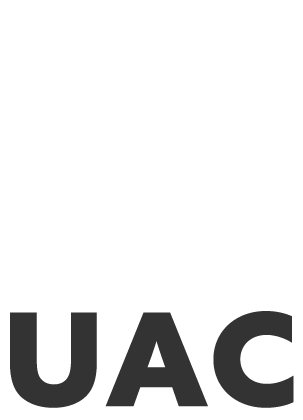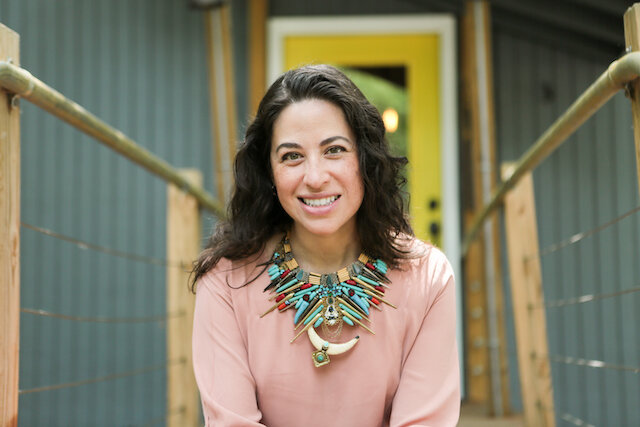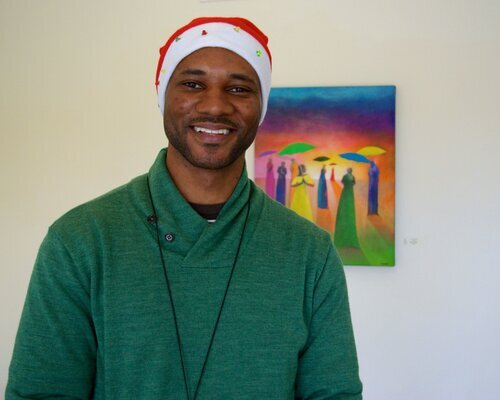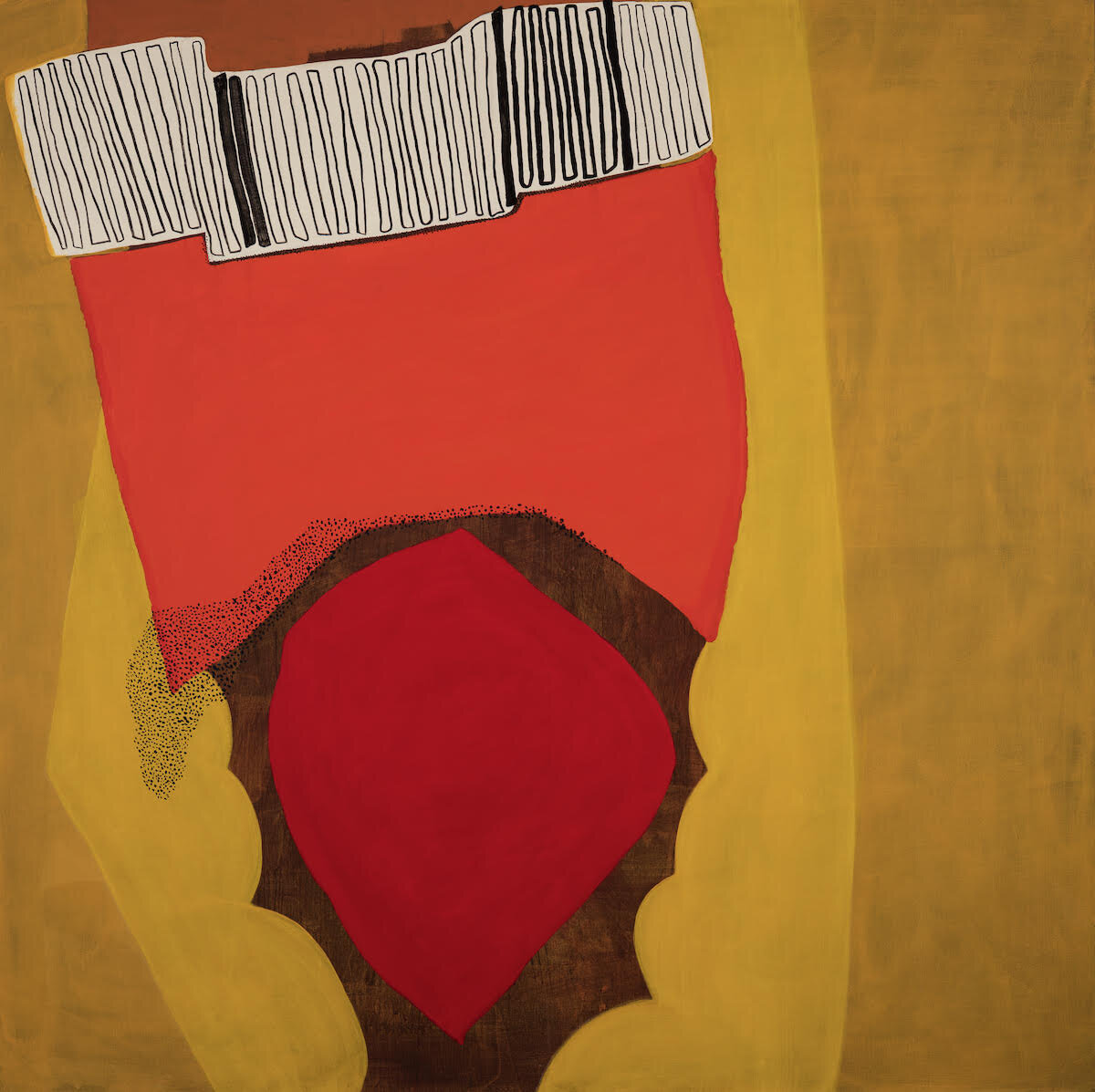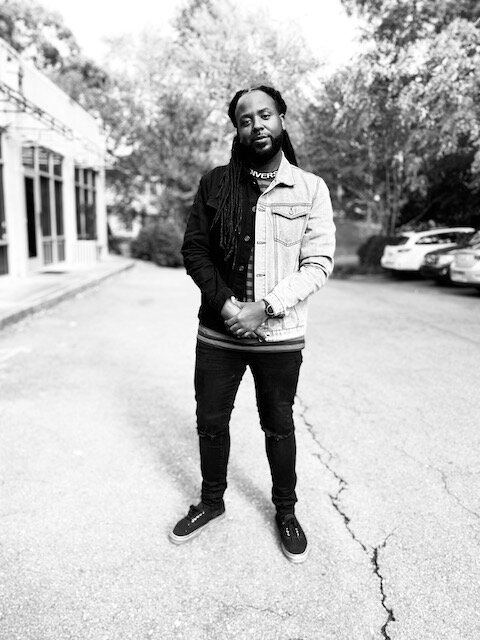The Memphis International Airport is being reimagined as the facility undergoes an important renovation to its B concourse. As part of the overall renovation, $1.5 million has been allocated to produce new site-specific public art projects at key locations throughout the facility. These projects include a large suspended sculpture, a mixed-media mural, a permanent exhibition of 2D work by local artists, and three art glass installations. We recently had the chance to catch up to some of the artists in charge of breathing life into this new facility to ask a few questions about the process so far
MEMPHIS INTERNATIONAL AIRPORT | INTERTWINING
Artist: Yancy Villa-Calvo & brg3s (Jason Jackson)
Inspired by woven tapestries, local artist and architecture team Yancy Villa-Calvo and brg3s’s dichroic plexiglass sculpture will bring vibrant colors and a message of community to the Memphis International Airport’s redesigned Concourse B. Villa-Calvo and brg3s applied as a team to a national call which garnered over 150 responses from artists across the country.
Why do you think it’s important to invest in public art?
Yancy Villa-Calvo
YVC: Public art has the power to engage the community in the process; it’s about all of us. Its accessibility has the power to activate a neighborhood, to highlight the identity of the community and its social context, and to enhance the shared space. When public art is created with the community in mind, the artist departs from being at the center to being a catalyst for a true art expression of the communal voice.
JJ: Public art offers everyone in our community the opportunity to engage in our shared values. Different perspectives are not just displayed but celebrated as we move through spaces that include art that supports us, challenges us, and maybe even makes us think about goals beyond ourselves. Communities thrive on our collective efforts and public art is the expression – and reminder- of the importance of the work that we do that serves to elevate us all. Public art supports our collective growth.
Have you learned anything that you would like to share from this project?
Intertwining, Yancy Villa-Calvo & brg3s
YVC: As with every original artwork , there is no written path or instruction manual. Therefore, it is a constant learning process the least of which is the complexity and the challenges that come with hanging a humongous work of art.
The lessons that come with designing a beautiful, abstract, and timeless work of art that communicates the message of what Memphis is, the richness of our diverse and inclusive community, and the welcoming feeling we want our visitors to experience when they arrive at MEM. I am learning more about the many talents that exist in Memphis. The architects, vendors, attorneys, engineers, fabricators, business owners and organizations who I’ve engaged with throughout this project have tremendous expertise and are passionate about their work. It has been an awesome experience with the architect firm, brg3s !
JJ: This project is unusual in so many ways, and it has already proven to be a learning experience. Our team has already developed complex new modeling techniques to address the sculptural needs of the space and project. More than that, though, we’ve learned just how willing the Memphis arts community is when it comes to collaboration and enhancing the artistic environment of our city in all public spaces.
What excites you about this project? What made you want to apply?
YVC: Everything about Intertwining is exciting but that doesn’t mean it is easy! It has been extremely complex and challenging which is why I find it fascinating; it keeps me on my toes and I wake up in the middle of the night with an idea or a possible solution to whatever we are facing at the time. The pandemic brought difficulties but also opportunities! All of my art projects ended abruptly, my work pipeline ended, and I was experiencing uncertainty.
The hanging installation call to artists attracted me the most because it was a challenge. I know my areas of expertise; but even more, I know the areas that need improvement and the ones with limited knowledge. Having the best players on my team where we complement each other increased the possibility of a successful outcome.
Jason Jackson
JJ: This sculptural message is deeply rooted in the wide variety of cultural stories that make up the Memphis community. The opportunity to tell those stories- and most importantly, the opportunity to put on display how we weave those stories together- is incredibly exciting and satisfying. Memphis is the perfect storyteller to share those lessons with visitors.
What is your background, and what inspired you to become an artist?
YVC: I am an interdisciplinary artist seeking to create awareness, engage in conversation, and encourage action on issues of social justice, equity, and community prosperity.
It was by accident that I discovered in my last semester of my undergrad degree at Christian Brothers University that I had abilities in the creative world. However, it was not until many years later that I decided to make a career out of it.
Intertwining, Yancy Villa-Calvo & brg3s
JJ: I started my college experience planning to become an artist, and even taught art before that. Along the way I moved from visual arts into architecture for the same reasons this project inspires me- I wanted to turn artistic visions into three-dimensional expressions usable and shareable by large numbers of people and impact their lives, even if only briefly as they pass through and around spaces, for the better.
Orange Mound Community Mural, Yancy Villa-Calvo
Why were you drawn to public art?
YVC: As a socially engaged artist, I find it fascinating learning about the individual stories and history of diverse neighborhoods which in turn, allows me to understand the different pressing issues of our times. With this knowledge and the resources organizations like the UrbanArt Commission and ArtsMemphis, offer to Memphis artists we can use our creative voices to live and amplify the Memphis story in many spaces of our city.
JJ: Whether or not we are aware of its impact, art affects us as we interact with it. Public art in particular is an extension of my own vision of what architecture is at its best: A way to impact people for the better, to make them think or laugh or learn by simply moving through a space. Public art creates those opportunities that make us better as people and better as a community.
What do you hope this project communicates to travelers passing through the Memphis airport?
Memphis Slim Collaboratory, brg3s
YVC: My hope is that anyone who experiences Intertwining feels joy because this piece has been designed and it’s being carefully crafted for each of them, for each of us.
JJ: The goal of this piece is to communicate a sense of space to visitors, as well as to give locals an impactful visual sendoff when they leave and a familiar welcome back when they arrive. The entire airport serves as a piece of beautiful architecture and public art, greeting us when we visit or come back to our great city, and the goal with this piece is to extend that hometown story and sense of ‘belonging’ to the interior of the airport as well. No matter where you’re going to or coming from, this piece should remind you that you’re not anywhere else: you’re here, in Memphis, where everyone is welcome home.
Intertwining night view, rendering
MEMPHIS INTERNATIONAL AIRPORT | WAITING AREA ART GLASS
Artists: Danny Broadway, Susan Maakestad, and Melissa Dunn
Paintings by Danny Broadway, Susan Maakestad, and Melissa Dunn will be printed on large glass walls, enlivening the waiting and restroom areas in the Memphis International Airport’s redesigned Concourse B. These projects and Call to Artists were specifically designed to invite Memphis-based artists to submit studiowork that would be fabricated and installed by separate vendors, opening up the opportunity for artists who don’t typically work in public spaces to apply.
Why do you think it’s important to invest in public art?
Danny Broadway
DB: I think that it is important to invest in public art because it helps to preserve the integrity and value of the artist's work.
SM: Public art expresses community identity and contributes to vibrant city spaces. It improves the quality of life for its citizens.
MD: Public art has been a part of our lives for tens of thousands of years. Investing in public art today says a city is investing in the quality of daily life for its citizens and visitors. Public art is far more than decoration, it’s a symbol of what it means to be human.
Susan Maakestad
Have you learned anything that you would like to share from this project?
DB: I’ve learned how better to work with a selection committee with the process of forming my work to fit around parameters.
SM: Unlike my solitary studio practice, this project has required working with others: the selection committee, UAC staff and the glass printers. I am still learning things as I go through this process. Ask me this question again when the massive windows are installed! I can hardly imagine my work recreated at a huge scale, with daylight passing through the colors.
Melissa Dunn
MD: Lately, I’ve been painting the digital designs I submitted for my application. Knowing they’ll be scanned and then printed on large glass panels with light pouring through has made me think about every brushstroke and subtle gradation of color in a whole new way. Having the opportunity to reframe my work in a different material and size has been a huge gift.
What excites you about this project? What made you want to apply?
DB: I’m excited to have my work permanently incorporated into the fabric of the Memphis Airport because I’ve created so much art while I’ve been living in Memphis.
SM: Although I am a mature painter I had no past experience creating public art. That is why I was thrilled to apply for this design-only call for artists. I am familiar with the quality of public art in Memphis and wanted to be part of it. I felt it would be an honor to see my work exhibited at a large scale in a setting where it will enjoy great visibility. I want to leave a lasting legacy in the city and to well-represent its art community to Memphis travelers.
MD: When I first read the description of this project I immediately thought that the visual language I use in my abstract painting would be a good fit. Airports around the world utilize artists to enhance spaces, making them more than just a thoroughfare of simply getting from here to there. As a native Memphian who loves to travel, I’m excited our airport is acknowledging the importance of art to the traveler’s experience.
Danny Broadway, previous work
What is your background, and what inspired you to become an artist?
DB: I was a quiet young boy that gravitated toward drawing. As I grew up, I had teachers and family members that encouraged me to continue to develop my skills until I developed a passion for making art.
SM: Even as a child, I loved school, especially the humanities, art and writing. Thanks to an influential college professor I recognized that all of my areas of interest could be absorbed into art-making. In fact, it wasn’t until college I understood a regular person could even be an artist. Up until that time art was something that only existed in books and museums. As a painting major in college and graduate school, I felt excited to have direction and meaning in my life. I was fortunate to then spend three decades as a college professor myself, educating young artists.
MD: I didn’t start making art until I was in college at the University of Memphis and took a drawing class on a whim. After that I knew I wanted to be an artist because I’m naturally a very curious person, and with art learning is infinite. My studio is in my house and there’s rarely a day that passes when I don’t make something. It’s how I move through life and the lens through which I see the world.
Susan Maakestad, previous work
Why were you drawn to public art?
DB: I am drawn to public art because it is something that I have always wanted to do more of and this was a great opportunity!
SM: I am drawn to the high visibility of public art. It is located where people live, work and congregate, not inside museum walls and galleries. It is exciting to see that livable and meaningful urban spaces can be created by artists and neighborhoods working together.
MD: I’ve been visualizing my work in the context of public art long before I applied for this project. Whenever I see public art that inspires me I ask how could my work contribute to this important civic function? Public art gives us a moment to have an aesthetic experience, which we are all wired to have. And whether the message of the art is one of social justice or abstraction, what it gives me is an opportunity to have an experience that is beyond words.
Melissa Dunn, previous work
What do you hope this project communicates to travelers passing through the Memphis airport?
DB: I hope that when people see my work in the airport, they will feel comforted about being in Memphis and excited about how the landscape and the people have a warm and welcoming existence.
SM: When viewing my work, I hope travelers will feel a sense of calmness, expansiveness and the grandeur of nature. As travelers navigate through the airport, I hope they will feel inspired by all the diverse and exceptional artwork on display. They will come to view Memphis as a sophisticated city that takes pride in its artists and appreciates the importance of visual art to the life of a vibrant city.
MD: When travelers move through a space where art is incorporated into thoughtful design, it speaks volumes to civic pride. It says “Welcome!” and is a symbol for the open-heartedness of our city. It also says, “Here in Memphis, we tend to our house.” Memphis has a long way to go to be beautiful for everyone in every neighborhood, but this project is an important part to eventually making that happen.
Danny Broadway, Concourse B Glass Wall Design
Melissa Dunn, Concourse B Glass Wall Design
Susan Maakestad, Concourse B Glass Wall Design
Eric Okdeh
MEMPHIS INTERNATIONAL AIRPORT | HEARTBEAT & SOUL
Artist: Jamond Bullock and Eric Okdeh
Two mixed-media murals, combining Jamond Bullock’s signature brushwork and Eric Okdeh’s mirrored mosaics, will greet travelers as they arrive and depart from the Memphis international Airport’s redesigned Concourse B.
Why do you think it’s important to invest in public art?
EO: Public art creates opportunities in cities for local artists. I’m fortunate enough have to lived in a city with a thriving mural scene for over 30 years. When I was in school, the focus was to show in NYC or LA or bust. I feel that when cities invest in public art and artists, like Memphis does, a new paradigm for the arts is created, and a distinct visual identity and culture soon follow.
JB: I think it’s important to invest in public art because it brings art to everyday people. It’s also great for creating a destination that lends itself for a story to be shared in the community in which the art is located.
What is your background, and what inspired you to become an artist?
EO: I've been a Philadelphia based painter almost all of my life. I started to get serious about art in the 7th grade, attending classes at a local arts school. That portfolio got me accepted to the High School for Creative and Performing Arts, and I completed my education with a B.A. in Painting from Tyler School of Art. High School was a wildly inspiring place, surrounded by so much talent in my peers and teachers. During my time there, a seed was planted and I knew this was what I needed to be doing with my life. I began getting involved in community-based public art as a freshman at Tyler in 1998, designing and painting murals in addition to my own work and classes. I've been doing this work ever since, this is my 22nd year creating murals and mosaics across the US and the world.
Jamond Bullock
JB: I am a Live painter, I own a company called Alivepaint. I specialize in event painting from concerts to weddings, fundraisers, and even funerals. You name it, I paint it. I curate an annual gallery show called Young, Gifted, & Dope, that features some of the most known, unknown, and critically acclaimed artists in the region. My main focus is storytelling with my studio pieces and public art practice. I often fuse abstract expressionism, fauvism, and pop art within my body of work. I have been inspired to become an artist because I am addicted to creating. Art runs through my bloodline on both my mom’s and dad’s side of the family. My grandfather was an artist and my brother is an artist. I always consider them to be my first art teachers. At an early age I knew I was a creative because when I was in elementary school and throughout high school I was fascinated with drawing even sometimes on my classwork.
Community Mural, Jamond Bullock
Why were you drawn to public art?
EO: Creating art in the public has opened me up to the concept of collaboration, be it with other artists and muralists, and with host communities. I get a charge out of acting as a conduit for relaying peoples’ stories and giving them a voice. I find reward in the inclusive nature of community-driven public art; the act of keeping the work out of galleries and museums to instead be in plain view in neighborhoods where people infuse their own meanings and interpretations, and take ownership in the work.
JB: I was pulled into mural making by my early clients after I graduated college. It started as a simple request to do mural work inside the homes of people that had commissioned work from me. After seeing my work at a larger scale and receiving positive feedback by others, I fell in love with murals quickly. The decision was made swiftly to figure out a way for my larger work to be seen in public spaces.
What excites you about this project? What made you want to apply?
EO: I’ve sporadically been traveling to Memphis since 2012, mostly as a consultant with UAC, for local artists looking to create and install murals. This is where I first met Jamond Bullock. I was drawn to his work and have been hoping to work with him and discover ways to merge our distinct styles. Glass mosaic enables me to collaborate with others effortlessly. We’ve really created some opportunities for complicated mosaic work in our Airport checkpoint mural, and I’m excited to fabricate the things we are envisioning. I remain impressed by Urban Arts history of public art and sculpture in the city, and the sights and sounds of Memphis itself. It’s an honor to be able to leave my mark!
Community Mural, Eric Okdeh
JB: The thought of creating two large mural pieces that will last multiple years inside the Memphis International Airport would excite any muralist. My mural work is connected to story telling and the human experience . Our artwork will connect with the migration of people . I applied to the this project because I love to travel, and felt it was time to jump on the opportunity to connect my artwork with a place that helps make Memphis become a destination.
What do you hope this project communicates to travelers passing through the Memphis airport?
EO: My hope Is that this project encourages travelers to look around, seek out, and immerse themselves in the experience and culture of Memphis.
JB: I hope people fall in love with the mural and have a sense of wonder and nostalgia while viewing some of the imagery. We all know that Memphis is rich with culture and known for its soul. This mural will communicate some of the hidden gems about our city and showcase the feeling of being at home.
Heartbeat & Soul, Jamond Bullock & Erik Okdeh
Artist Information
Yancy Villa-Calvo
Instagram: @yancyart
Website: yancyart.com
Jason Jackson
Instagram: @brg3s_architects
Website: brg3s.com
Danny Broadway
Instagram: dannybroadway
Website: dannybroadway.com
Susan Maakestad
Instagram: susan_maakestad
Website: susanmaakestad.com
Melissa Dunn
instagram: lemissadunn
Website: www.melissadunn.net
Eric Okdeh
Instagram: okdehmurals
Website: ericokdeh.com
Jamond Bullock
Instagram: alivepaint
